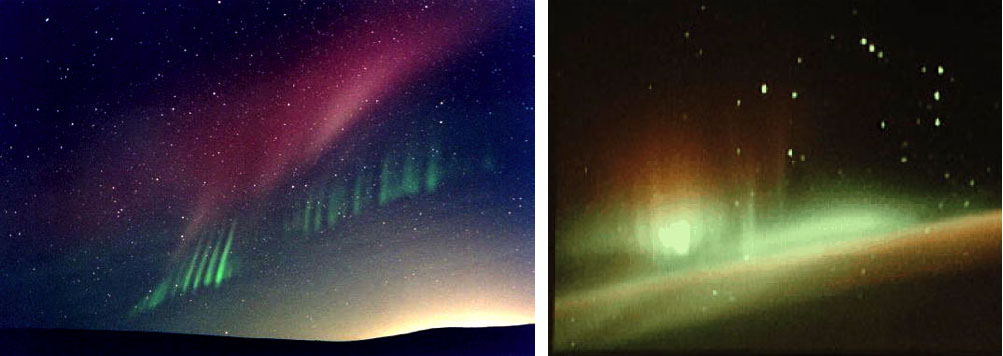
home •
about •
essential guide •
picture of the day •
thunderblogs •
news •
multimedia •
predictions •
products •
get involved •
contact
picture of the day archive subject index
The image above has been rotated 90 degrees clockwise and processed by the “auto contrast” function in
Photoshop to accent the curious placement of dark spots on the south polar “frost” of Mars.
Credit: NASA/JPL/MSSS
May 21, 2007
"Dalmatian Spots" of Mars' South PoleMysterious dark spotting on Mars’ south polar ice cap provides numerous clues to the nature of electrical events in the region. But NASA scientists show no interest in the charged particle streams that, evidence suggests, continually alter the surface.
For almost nine years now, planetary scientists have commented on strange events occurring in and around the south pole of Mars. They’ve expressed curiosity, puzzlement and amazement. They’ve offered theories, then retracted them, as cameras returned better images and the mysteries grew.
The picture above was returned by the Mars Orbiter Camera in 1999. The picture shows a “dune field” located at 61.5°S, 18.9°W, as it appeared on July 1, 1999. For planetary scientists such spots seen on “defrosting” polar dunes were a new phenomenon, unseen by previous spacecraft missions to Mars. They came to be known as “dalmatian spots.”
According to NASA investigators, “The patterns created by dark spots on defrosting south polar dunes are often strange and beautiful … The spots are areas where dark sand has been exposed from beneath bright frost as the south polar winter cap begins to retreat.”
This explanation of the dark spots is not sufficient. Many instances could be given showing ice being progressively removed to expose dark surface material. But what is the mechanism removing ice so selectively at discreet spots, often reaching deep into the ice to produce distinct cavities (a subject of the Picture of the Day to follow in this series)?
The authors of the NASA caption write, “…No one yet knows why the dunes become defrosted by forming small spots that grow and grow over time. No one knows for sure if the bright rings around the dark spots are actually composed of re-precipitated frost. And no one knows for sure why some dunes show spots that appear to be "lined-up" (as they do in the picture above).”
Eight years after this caption was written, the mysteries have only deepened. But still we can find no mention by NASA of electrical possibilities. Could electric discharge be excavating the spots on the ice? Discharge frequently occurs in discrete columns, as in the discharge experiment photograph on the left. (Many variations on the basic pattern could be given). Here, the image was recorded through a transparent electrode, and the white spots are the discharge itself. (See “Static and dynamic two-dimensional patterns in self-extinguishing discharge avalanches,” by W. Breazeal, K. M. Flynn, and E. G. Gwinn, Physical Review E, August 1995.)
Is it common for discharge streamers to “line up” in a fashion that could account for the loose alignment of dark spots on the Martian ice pictured above? The authors of the laboratory investigation noted here report that when discharge spots stand in close proximity the regions between them tend to fill in to give the appearance of “beads on a string.” The result is a general appearance of striping, as seen on the left. (On the surface of Mars, innumerable striping effects are in fact among the most perplexing enigmas.)
In laboratory discharge many different striping patterns occur under different conditions. The sample given on the lower left is from a paper by Lifang Dang et al.,”Observation of spiral pattern and spiral defect chaos in dielectric barrier discharge in argon/air at atmospheric pressure” Physical Review E 72 (2005).
The lining up of discharge columns is commonly seen in the Earths auroras (north polar aurora below left, and Aurora Australis below right). Of course the electrical cause of auroral activity underscores the logical priority on the study of spotting concentrated in the polar regions on Mars. Of the known physical events whose effects on surface materials can be studied, is there anything other than electric discharge that can account for the details observed on the Martian surface? In the case of Earth’s aurora, the atmosphere serves to insulate the surface substantially from the discharge activity of the aurora. But this is certainly not the case with the planet Mars, whose rarified, but electrified atmosphere would be more accurately called a plasma. Moreover, as we've noted in discussing global dust storms on Mars, the planet’s elliptical orbit means that it travels much farther through the radial electric field of the Sun, adding greatly to the potential for electrical activity on the planet.
Until the cause of the dark spots on the ice is explained, it is not rational to separate this issue from equally enigmatic dark spots observed elsewhere on the planet’s surface--as on the “sand dunes” of Russell Crater observed in our latest Pictures of the Day. Surely, in a search for answers, one cannot justify ignoring similar unexplained patterns just because of a dubious theoretical assumption (“no electricity in space”).
In this TPOD series, we intend to show that by simply following a line of electrical investigation that NASA has ignored, one Martian mystery after another will find its logical explanation.
![]()
home •
thunderblogs •
forum •
picture of the day •
resources •
team •
updates •
contact us
EXECUTIVE EDITORS:
David Talbott, Wallace Thornhill
MANAGING EDITORS:
Steve Smith, Mel Acheson
CONTRIBUTING EDITORS: Michael Armstrong, Dwardu Cardona,
Ev Cochrane,
C.J. Ransom, Don Scott, Rens van der Sluijs, Ian Tresman
WEBMASTER: Brian Talbott
Copyright 2007: thunderbolts.info

